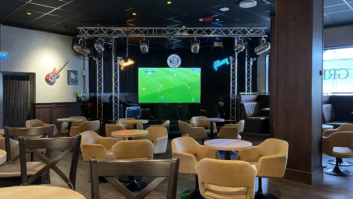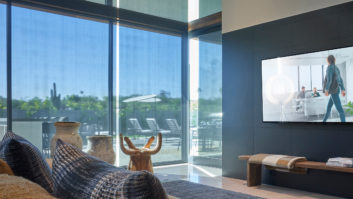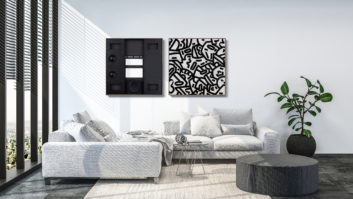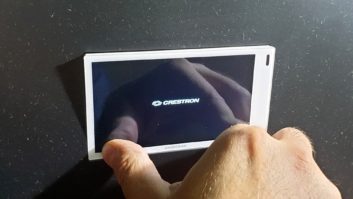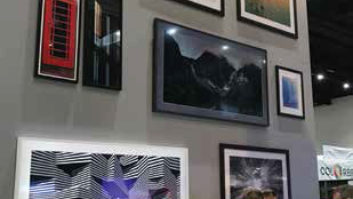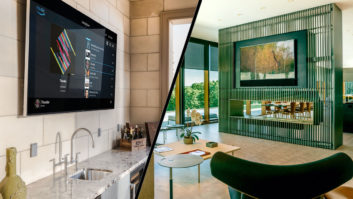How ESCs are Integrating Apple’s Latest Touchscreen Technology


Quentin Jones, a systems programmer for Sioux Falls, South Dakota’s Workplace Technology Center, noted that the iPad’s versatility and wide presence means that it is a less intimidating platform for the end user. For Jones, one of these potential clients turned out to be the president of his own firm, who was looking to redesign his AV system. While the system also includes traditional touchpanels and keypads, he found it very easy to integrate the iPad with Crestron (picture in the top photo above and right).
Last month, during Apple’s Worldwide Developers Conference in San Francisco, the company’s CEO Steve Jobs announced that it had sold two million iPads in two months. Long anticipated by the self-proclaimed geek segment of the tech world, the iPad is selling better than even they expected. And as Apple Computers surpasses Microsoft to become the world’s most valuable technology company for the first time in their ongoing rivalry, touchscreen manufacturers have not wasted any time in capitalizing on Apple’s latest innovation. So far, Crestron, AMX, Control4, and Savant Systems (whose products were established on Apple’s operating system from the very beginning) have all created applications (apps) specifically geared for integration with the iPad.
While it seems counter-intuitive to create software on what is essentially a rival’s platform, one only needs to look at what happened to record companies when they failed to acknowledge the influence of Apple’s MP3 player, the iPod. It might be impolite to say that resistance is futile, but manufacturers have solid feedback from integrators whose field reports reflect a client base that has grown accustomed to the sleek, intuitive iPhone/iTouch/iPad interface.
“Apple and its “iProducts” are well known and viewed by most consumers in a positive way,” said Steve Immerman, president and CEO of Cincinnati-based integration firm, Premier Network Solutions. “In many of our clients’ eyes there is a certain ‘wow’ factor for integrators to be able to tie that technology into automation and control.”
Why an iPad?
Integrators have already tapped into the multitouch and wireless innovations of the iPhone and iTouch, but have always been limited by the small 3.5-inch screen of those devices. With the introduction of the iPad and its 9.7-inch screen, the possibilities have suddenly expanded.
Packed with many of the same features as the iPhone (minus a phone), the iPad has two things that make it a worthy stand-in for many touchscreen remotes: it weighs 1.5 pounds, so is very light and very thin; and, with a starting price of $499 it is relatively less expensive than many branded touchpanels on the market. That it is capable of doing several disparate tasks (though only one at a time) from one device makes it revolutionary.
“Benefits are in that the iPad is a multi-purpose device that can also be used to control your house,” said Dick Rozic, president of Aveon Inc., an integration company in Houston, Texas. “Just like the Control4 remote can get rid of lots of traditional remote controls, the iPad can morph and fulfill many different functions in one convenient device.”
It’s a point that has been reiterated time and time again by several other integrators. In a recent Cincinnati, Ohio, installation, Premier’s Immerman and his team were given the task of providing home automation from one source. The client, who was used to controlling their automation system with Crestron touchpanels and an iPhone running Crestron’s app, became the perfect candidate for an integrated-iPad system.
“When the iPad came out, we made the connection that the client might enjoy the same convenience within the home with a larger interface,” Immerman explained. “The larger interface enhances our client’s ability to view detailed information associated with the home automation; for example, the larger interface makes it easy for the client to view images on the security camera. Because we already knew the client enjoyed this type of convenience, we found the iPad to be the perfect fit.”

It also gets the attention of a very specific kind of client. Quentin Jones, a systems programmer for Sioux Falls, South Dakota’s Workplace Technology Center, noted that the iPad’s versatility and wide presence means that it is a less intimidating platform for the end user. “[It’s] a highly economical alternative to traditional touchscreens, and as such opens Crestron to a wider small business and residential market,” he said. “Many potential clients who might not be willing to invest in a control solution with a traditional touchscreen already have iPads.”
For Jones, one of these potential clients turned out to be the president of his own firm, who was looking to redesign his AV system to correct initial design deficiencies and damage after the home was struck by lightning. With several functions needing control, including high-definition video and zoned audio, the key to Jones’ installation was his boss’s need to have an intuitive system that was accessible to family members, young children, and casual users like babysitters and grandparents.
We chose to use the iPad because it has an attractive display and gave the system a fresh, new feel,” Jones said. “While the system also includes traditional touchpanels and keypads, we found it very easy to integrate the iPad with Crestron. I had the system up and running with the iPad and Command Fusion’s app (CF iViewer) two days after the iPad’s release.”
Drawbacks to Beauty
Of course, client satisfaction is vital to the life of any integration firm. David Robbins, owner and president of Next Level Systems in McKinney, Texas, who often integrates Savant Systems’ products, sings the praises of the iPad as much as the next integrator. In fact, he notes that he can now leverage the sophistication of Savant’s cache of products with the iPad thanks in large part to Savant’s beautiful iPad app, Rosie 4i—an approach he used during a recent integration project in Highland, North Carolina, where the clients were the challenge. Robbins’ clients, an older couple in their fifties and sixties, were not technology adopters. Their vacation home’s automation system had to be simple enough to be learned in two minutes.

Quentin Jones says that many potential clients who might not be willing to invest in a control solution with a traditional touchscreen already have iPads.
“I needed a wireless control system and the only other traditional wireless control from Savant is considerably more expensive and too heavy to carry around,” Robbins explained. “The main advantage to the iPad is its ease of use. This is the result of thousands of hours of development of the app by Savant allowing the creation of one of the best-built user interfaces I have ever seen. The time and expense for me to develop something close to this is enormous. I can leverage the sophistication that Savant has already provided and do it at a much lower cost to the client. In the past, to have something this good would have cost tens of thousands of dollars. Now it is less than $600 total.”
In addition to the cost savings for an expensive-looking control device, Robbins also makes a significant point about what the device ultimately means for integrators. “The disadvantage to all of this is now we, as dealers, must find new ways to create revenue. There is no money to be made by simply selling an iPad.”
Robbins is right. Shifting product margins are one of the biggest challenges facing system integrators, especially in the current economic climate. But the power of the add-on is still a viable way to keep and get new clients, as well as to keep manufacturers names and branding power in the conversation.
“I see this device being an excellent add-on,” said Aveon’s Rozic. “Over time, we’ll see accessories like docking stations—both tabletop and wall mount—that will make these devices more natively integrated to our designs, but at the moment the iPad is another dimension to our same solution.”
Will the iPad Take Over?
To listen to both integrators and manufacturers, the iPad will have a place in sophisticated installation projects, but it will not become the central gateway to complex and intricately designed systems. The word that came up most often when integrators were asked to describe what the iPad means for system integration was “tool.” As an add-on to an existing system it has the ability to draw the end user in, but is still lacking in some basic functionality. Its inability to multitask and lack of Flash animation software are both severe handicaps that make the iPad less of a threat to existing touchscreens made by companies like Crestron, Control 4, and Savant Systems.
“I don’t see the iPad changing how integrators design systems,” Robbins said. “In the end, it is simply a less expensive wireless control device and functions much the same as control devices have in the past. What I do see is that a sophisticated level of control is now available to a consumer previously unable or unwilling to purchase such a system.”
Rozic, who has used the iPad in three of Aveon’s installations thus far, said he did not choose the device in lieu of Control4 touchscreens, but as an alternative control point for the installations’ current system functionality. “We’ve haven’t changed our system design approach, we just believe the iPad is another option and convenient way to control your house.”
Mixing the Old with the New

The Kaleidescape media server interface on the iPad integrated by Invision
Invision Home Systems knows a thing or two about integrating the iPad into existing home automation systems. The ESC firm recently landed a client whose 10-year-old AV system was in desperate need of an upgrade.
“Since this was an existing home with a detached guest house being added, we were only able to run wires in the new structure,” said Steve Berger, Invision’s sales manager. “The existing wiring allowed for a traditional touchpanel to be added in two locations, but the customer wanted to have control in every room. The iPad was selected as the control interface for these areas as it would provide a cost-effective, portable interface for controlling music, lights and viewing cameras in rooms without a traditional touchpanel.”
The installation was achieved with the addition of Crestron automation and Crestron lighting control systems, a Kaleidescape media server, iPod dock, and Blu-ray player. In addition to the successful home-based installation, Invision helped its client to keep in touch with her home while traveling, by creating a custom interface for the light control system with the help of an app purchased on Apple’s iTunes store, which allowed the client to control her lighting and DVR from anywhere in the world.
Mac Lovers Unify Systems with iPad Applications

Craig DeAndrea
Shortly after purchasing two iPads, a Ridgewood, New Jersey, couple became aware of what Savant Systems had to offer. Having lived with a complex AV system for five years, the couple saw the potential in using their new iPads to control their audio and video in the den and living room.
“I came up with a simple solution that would tie everything together nicely and provide full two-way system control throughout,” said Craig DeAndrea, vice president of Woodbridge Stereo/Video in Woodbridge, New Jersey. “After reviewing this with the client…I suggested we integrate the rooms by using the Savant Protégé Multi-Room Audio and Control Solution and use their iPad and iPhones with the corresponding Savant ROSIE Apps for the ultimate in portable two-way system control.”
DeAndrea acknowledges that in this case, the primary benefit of using the iPad was cost savings with multi-function support running a close second. But like his fellow Savant Systems dealer, Next Level Systems’ David Robbins, he sees the impact on the integrator’s bottom line if iPad integration is not handled properly.
Turning the Lights on in Texas


Before introducing Control4 automation to this cacophony of lights, Texas-based integration firm, Diem Digital Interiors, was told that its client was using his PC to ineffectively control the switches.
In Richardson, Texas, there is a man who had 30 lighting dimmers and nine thermostats in a closet. There also were 19 lamps and Christmas decorations in need of some control. Before introducing Control4 automation to this cacophony of lights, Texas-based integration firm, Diem Digital Interiors, was told that its client was using his PC to ineffectively control the switches.
“The customer is an iPad enthusiast, who heard about Control4’s focus on integrating their entire system with the iPad,” said Diem Digital president John Dorsey.
With the addition of an iTunes Store app to help control the DIY er’s security system, the Diem Digital team used Control4 to automate the client’s lighting and HVAC systems, which he can also control from his iPad. “It makes wireless touchscreens more affordable, therefore more attainable, to more customers,” Dorsey said. “For example, the iPad is cheaper than some handheld remotes and has a lot more functionality. Additionally its long battery life allows for someone to use it all day, only needing to charge it at night.”
Llanor Alleyne is a contributing editor to Residential Systems, in Brooklyn, New York.
